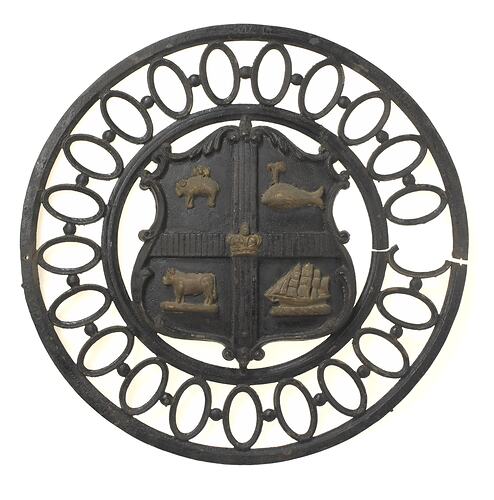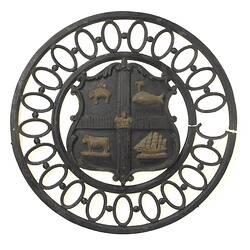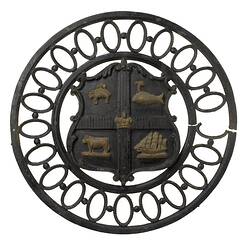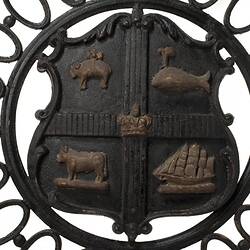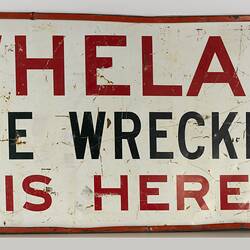Summary
Cast-iron coat of arms or emblem of the City of Melbourne. This coat of arms came from the Eastern Market, at the corner of Bourke and Exhibition streets. The market was founded in 1847 and rebuilt in 1879. The coat of arms was repeated in the spandrel panels of the cast iron columns of the 1879 market buildings.
One of the first actions of the newly established Melbourne Town Council in 1842 was to approve its seal and coat of arms. The design of the coat of arms reflects much about early Melbourne. The Cross of St George and Royal Crown declare the town's allegiance to Great Britain. The sheep, bull and whale represent the colony's chief exports in 1842 - wool, tallow (animal fat) and whale oil - and the ship depicts the settlement's means of communication with the outside world.
The market buildings were demolished in 1960 by Whelan the Wrecker (to make way for the Southern Cross Hotel). This object is part of a collection of industrial signs and posters collected by the staff of Whelan the Wrecker as buildings were demolished, and later donated to the Museum.
Physical Description
Cast iron unpainted circle coat of arms within a circle. Outer rim filled with oval shapes joined by orbs of iron. Top and bottom of ovals join onto the two circles. City of Melbourne shield inside small centre circle. The shield is divided into four parts. Top left shows a sheep; top right a whale; lower left a cow and lower right a sailing ship. The coat of arms appears to have been burnt at some stage. Breaks in inner and outer circle on centre right side. The coat of arms was originally painted; it is now generally rusty and burnt. Two holes for attachment at 9 and 3 o'clock.
Significance
This cast-iron emblem is significant as a remaining decorative element of the Eastern Market, which operated in Bourke Street from 1840 to about 1960. As the builder and operator of the city markets, the City of Melbourne had their coat of arms incorporated into the spandrels of the arcades and verandahs of the redeveloped market site in 1879. It is also significant as a relatively early portrayal of Melbourne's coat of arms, especially in an architectural form.
More Information
-
Collection Names
-
Collecting Areas
-
Acquisition Information
Donation from Mr Myles Whelan, 23 Jun 1992
-
User
Melbourne City Council, Eastern Market, Melbourne, Greater Melbourne, Victoria, Australia, 1879-1960
-
Collector
Whelan the Wrecker, Eastern Market, Melbourne, Greater Melbourne, Victoria, Australia, 1960
-
Classification
-
Category
-
Discipline
-
Type of item
-
overall dimensions
83 cm (Length), 5 cm (Width), 83 cm (Height)
circular
-
Exhibition Collection Management
65 mm (Length), 835 mm (Width), 29 (Weight)
Width = Diameter
-
Maximum dimensions
50 mm (Length), 830 mm (Width), 830 mm (Height)
Measurement From Conservation.
-
References
-
Keywords
